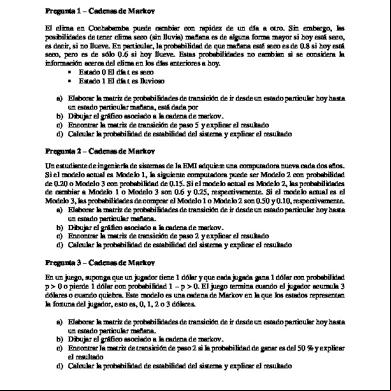Non-threatening Environments In Education 176a6q
This document was ed by and they confirmed that they have the permission to share it. If you are author or own the copyright of this book, please report to us by using this report form. Report 2z6p3t
Overview 5o1f4z
& View Non-threatening Environments In Education as PDF for free.
More details 6z3438
- Words: 770
- Pages: 3
1
RUNNING HEAD: Non-Threatening Environments in Education
Non-Threatening Environments in Education By Prof. Jonathan Acuña Solano Sunday, June 21, 2015 Twitter: @jonacuso Post 176
When one steps into a classroom, what is the most common behavior that can be sensed and witnessed? Though overgeneralizations should not be made to try to for the kind of environment that is most common, say, in Costa Rican language classrooms, a researcher is bound to identify either threatening or non-threatening atmospheres that no doubt will have an incidence in the quality of learning expected from students sitting in class. The question that ought to bugle in the instructors’ ears is, how can I provide my pupils a non-threatening environment to help them learn? After working on mindfulness in the last six months of the year with SIT TESOL scholar, Mary Sholl, I have come to fully comprehend the necessity to strive for the creation of “safe, creative, reflective, and fun environments that enable … learners to really focus on their learning” (SpiralMana.Org, n.d.). Mindfulness in what we do in education is a door to create non-threatening environments that can foster student learning in the classroom and beyond its boundaries. Being aware of what others think
Prof. Jonathan Acuña Solano
2
Non-Threatening Environments in Education
and feel is a way to become mindful of what we do to our students within the class setting.
# 1 2 3 4 5 6 7 8 9 10
How often do I do this? Greeting students with lots of enthusiasm at the beginning of class Providing time for students to share happenings, events, situations in their lives Sharing bits of important life events with learners to create your learning community Clarifying the importance towards respecting differences and diversity in the classroom Saying no to any kind of bullying and embracing tolerance among class Deg and developing activities that foster team work and cooperation among peers Only focusing on the strengths learners have when calling for participation Promoting two-way respect among class including yourself Helping class cope with difficulties they may be facing together or individually Promoting confidence and self-esteem among learners
Always
Not Always
Created by Prof. Jonathan Acuña and adapted from Watson, S. (n.d.). How to Create a Non-Threatening, Welcome Classroom Environment
The checklist/rubric provided above is just a way to self-assess how mindful we are in regards to the practices that Watson (n.d.) suggests reviewing to create a nonthreatening classroom environment. My idea behind this rubric-like checklist is to help myself and others to mindfully reflect, as taught by Mary Sholl, upon areas that can affect the well-being of students in class: 1) teacher social presence in class, 2) allowing
students to gain confidence with you, the teacher, 3) sharing bits of our lives to become of a learning community, 4) respect for differences and variety present in class, 5) embracing tolerance rather than bullying the one who is different, 6) the fostering of Prof. Jonathan Acuña Solano
3
Non-Threatening Environments in Education
teamwork and cooperation to achieve goals, 7) the importance of focusing on the right psychological traits of each student, 8) the promotion of two-way respect among all class , 9) copying with difficulties or hardships learners may be facing, and 10) the promotion of confidence and self-esteem. As pointed out by Finch (2001, October), “given the tendency of language classrooms to promote debilitative anxiety, the promotion of a low-stress language learning environment must be an important priority for the teacher.” In the end this is going back to the premises of learning outlined by Krashen’s affective filter; whatever we teachers do in class that affects the natural synergy present in the classroom will trigger a peak in anxiety that will not help the learner to achieve the learning goals proposed by the teacher in his/her lesson plan. The whole curricula will be affected, and our lack of mindfulness will ruin the learning process for the students who will –no doubt- feel threatened in an environment that is not friendly for them.
Centro Espiral Mana. (n.d.). What do we believe about learning and how do we put those beliefs into practice. Retrieved on 2015, June 20 from the Centro Espiral Mana webpage at http://www.espiralmana.org/our-philosophies-of-learning.html Finch, Andrew. (2001, October). The Non-Threatening Learning Environment. Retrieved on 2015, June 20 from the Academia.Edu webpage at http://www.academia.edu/6022977/The_Non-threatening_Learning_Environment Watson, S. (n.d.). How to Create a Non-Threatening, Welcome Classroom Environment. Retrieved on 2015, June 20 from the About.Education webpage at http://specialed.about.com/od/teacherchecklists/a/classroom.htm
Prof. Jonathan Acuña Solano
RUNNING HEAD: Non-Threatening Environments in Education
Non-Threatening Environments in Education By Prof. Jonathan Acuña Solano Sunday, June 21, 2015 Twitter: @jonacuso Post 176
When one steps into a classroom, what is the most common behavior that can be sensed and witnessed? Though overgeneralizations should not be made to try to for the kind of environment that is most common, say, in Costa Rican language classrooms, a researcher is bound to identify either threatening or non-threatening atmospheres that no doubt will have an incidence in the quality of learning expected from students sitting in class. The question that ought to bugle in the instructors’ ears is, how can I provide my pupils a non-threatening environment to help them learn? After working on mindfulness in the last six months of the year with SIT TESOL scholar, Mary Sholl, I have come to fully comprehend the necessity to strive for the creation of “safe, creative, reflective, and fun environments that enable … learners to really focus on their learning” (SpiralMana.Org, n.d.). Mindfulness in what we do in education is a door to create non-threatening environments that can foster student learning in the classroom and beyond its boundaries. Being aware of what others think
Prof. Jonathan Acuña Solano
2
Non-Threatening Environments in Education
and feel is a way to become mindful of what we do to our students within the class setting.
# 1 2 3 4 5 6 7 8 9 10
How often do I do this? Greeting students with lots of enthusiasm at the beginning of class Providing time for students to share happenings, events, situations in their lives Sharing bits of important life events with learners to create your learning community Clarifying the importance towards respecting differences and diversity in the classroom Saying no to any kind of bullying and embracing tolerance among class Deg and developing activities that foster team work and cooperation among peers Only focusing on the strengths learners have when calling for participation Promoting two-way respect among class including yourself Helping class cope with difficulties they may be facing together or individually Promoting confidence and self-esteem among learners
Always
Not Always
Created by Prof. Jonathan Acuña and adapted from Watson, S. (n.d.). How to Create a Non-Threatening, Welcome Classroom Environment
The checklist/rubric provided above is just a way to self-assess how mindful we are in regards to the practices that Watson (n.d.) suggests reviewing to create a nonthreatening classroom environment. My idea behind this rubric-like checklist is to help myself and others to mindfully reflect, as taught by Mary Sholl, upon areas that can affect the well-being of students in class: 1) teacher social presence in class, 2) allowing
students to gain confidence with you, the teacher, 3) sharing bits of our lives to become of a learning community, 4) respect for differences and variety present in class, 5) embracing tolerance rather than bullying the one who is different, 6) the fostering of Prof. Jonathan Acuña Solano
3
Non-Threatening Environments in Education
teamwork and cooperation to achieve goals, 7) the importance of focusing on the right psychological traits of each student, 8) the promotion of two-way respect among all class , 9) copying with difficulties or hardships learners may be facing, and 10) the promotion of confidence and self-esteem. As pointed out by Finch (2001, October), “given the tendency of language classrooms to promote debilitative anxiety, the promotion of a low-stress language learning environment must be an important priority for the teacher.” In the end this is going back to the premises of learning outlined by Krashen’s affective filter; whatever we teachers do in class that affects the natural synergy present in the classroom will trigger a peak in anxiety that will not help the learner to achieve the learning goals proposed by the teacher in his/her lesson plan. The whole curricula will be affected, and our lack of mindfulness will ruin the learning process for the students who will –no doubt- feel threatened in an environment that is not friendly for them.
Centro Espiral Mana. (n.d.). What do we believe about learning and how do we put those beliefs into practice. Retrieved on 2015, June 20 from the Centro Espiral Mana webpage at http://www.espiralmana.org/our-philosophies-of-learning.html Finch, Andrew. (2001, October). The Non-Threatening Learning Environment. Retrieved on 2015, June 20 from the Academia.Edu webpage at http://www.academia.edu/6022977/The_Non-threatening_Learning_Environment Watson, S. (n.d.). How to Create a Non-Threatening, Welcome Classroom Environment. Retrieved on 2015, June 20 from the About.Education webpage at http://specialed.about.com/od/teacherchecklists/a/classroom.htm
Prof. Jonathan Acuña Solano











